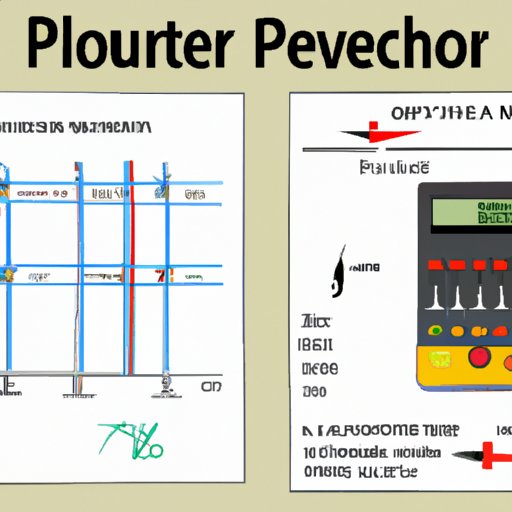
I. Introduction
Power calculation is a vital aspect of physics, engineering, and technology. It measures the rate at which work is done or energy is consumed. Accurately calculating power is crucial as it ensures safe operation, optimum design, and efficient energy usage. This article is a beginner’s guide to power calculation, aimed at anyone seeking to understand the basics and beyond. Whether you are a physics enthusiast, an engineer, or someone curious about how the devices around us work, this article will provide you with a comprehensive understanding of power calculation.
II. The Physics of Power: A Step-by-Step Guide to Calculating Power in Any System
In physics, power is defined as the rate at which work is done or energy is transferred. It is measured in watts (W), which is equal to joules per second. The basic formula for calculating power is:
Power = Work / Time
or
Power = Energy transferred / Time
To calculate power, you need to know the amount of work (or energy) done or transferred in a specific amount of time. Here is a step-by-step guide to calculating power in a system:
- Determine the amount of work done or energy transferred in the system.
- Measure the time it took for the work to be done or energy to be transferred.
- Divide the work (or energy) by the time to get the power in watts.
III. Demystifying Power Calculation: How to Determine the Strength of Your Device
Knowing the power of a device is essential in determining its performance and limitations. For example, a device with a high power rating may consume more energy than one with a lower rating. Steps to determine the power of a device include:
- Identify the device’s voltage and current ratings.
- Multiply the voltage by the current to get the device’s power rating in watts.
Here are some common devices and their power ratings:
- Smartphone charger – 10 watts
- Laptop – 45-90 watts
- Desktop computer – 300-500 watts
- Hairdryer – 1200-1800 watts
- Microwave oven – 600-1200 watts
IV. Harnessing the Power of Math: A Beginner’s Guide to Calculating Power
Math plays a crucial role in power calculations, especially when dealing with electrical systems. To understand power, you need to be familiar with some key mathematical concepts like voltage, current, and resistance. Here are some common formulas used in power calculations:
- Power = Voltage x Current (for DC circuits)
- Power = Voltage x Current x Power Factor (for AC circuits)
- Power = Current² x Resistance (for DC circuits)
- Power = (Current² x Resistance) x Power Factor (for AC circuits)
V. Powering Up Your Calculations: Tips and Tricks for Accurate Power Calculations
To ensure accurate power calculations, you need to pay close attention to several factors, including:
- Unit consistency – Ensure that all values are in the same units (e.g., watts, volts, amps) before making a calculation.
- Rounding errors – Keep intermediate values in the calculation to avoid errors from rounded values.
- Measurement accuracy – Accurate measurements are essential for precise calculations. Always use reliable measurement tools.
Common mistakes to avoid when calculating power include:
- Mistaking energy for power
- Miscalculating power factor
- Applying the wrong formula for AC/DC circuits
Challenges that may arise during power calculations include:
- Dealing with varying power factors in AC circuits
- Measuring power in appliances with non-linear loads
- Calculating power for devices with multiple voltage/current ratings
Addressing these challenges requires a combination of knowledge, experience, and problem-solving skills.
VI. From Watts to Joules: Understanding the Basics of Power Calculation
Watts and joules are both units used to measure power, but they differ in their application. Watts measure the power dissipated in a circuit, while joules measure the energy stored or transferred within a system. To convert between watts and joules, you need to know the time interval. Here is an example:
If a 60-watt light bulb is turned on for 5 seconds, the energy consumed is:
Energy = Power x Time
Energy = 60 watts x 5 seconds = 300 joules
VII. Calculating Power in Electrical Circuits: An In-Depth Look at the Methods and Formulas
In electrical circuits, power is calculated based on the voltage and current in the circuit. The relationship between voltage, current, and power is given by the formula:
Power = Voltage x Current
For AC circuits, the power factor (the ratio of actual power to apparent power) must also be considered. The formula for calculating power in AC circuits is:
Power = Voltage x Current x Power Factor
The type of circuit (AC or DC) determines which formula to use. DC circuits have a constant voltage, while AC circuits have a varying voltage.
VIII. Empowering Your Engineering Skills: A Practical Guide to Calculating Power in Any Project
Power calculations play a crucial role in engineering projects, as they help in determining the appropriate design and energy usage. Some tips on how to apply power calculations in engineering projects include:
- Start with the device’s power rating to ensure safe operation.
- Determine the energy efficiency of the system by calculating the input and output power.
- Optimize the power usage by selecting components with the appropriate ratings and minimizing power losses.
Common challenges encountered in engineering projects include integrating multiple devices with different power ratings and dealing with load fluctuations. Addressing these challenges requires careful planning and implementation.
IX. Conclusion
Calculating power is an essential aspect of physics, engineering, and technology. It involves complex formulas and calculations, but with a little knowledge and practice, anyone can understand the basics and beyond. Accurately calculating power is vital in ensuring safe operation, optimum design, and efficient energy usage. We hope this guide has provided you with the knowledge and tools to succeed in your power calculations. Remember, always double-check your calculations, and never be afraid to ask for help when needed.





